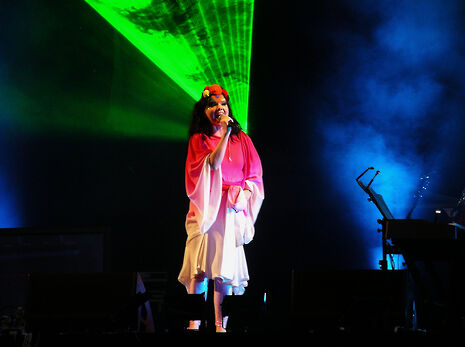Album: Vulnicura, Björk
Björk sheds concept and returns to her emotional pop roots

As well as misspelling several track titles, the low-quality leak which prompted Vulnicura’s surprise release rather poetically tagged the album’s genre as ‘Other’. While this only superficially covers Björk’s extreme brand of pop, this album truly is a departure from previous form, and marks a return to the contours of her legendary albums in the late 90s.
Björk’s album artwork usually gives a feel for the music it accompanies – in 2011, Biophilia presented her as a sci-fi Gaia. By contrast, Vulnicura features her hovering, doll-like, in a leather catsuit with what looks midway between a vagina and a gaping wound in her chest. The album’s tone matches the image with unerring accuracy; despite its otherworldly exterior, it is profoundly human. Björk has ripped open her chest and candidly revealed what lies inside it.
Vulnicura’s subject matter is by far her most brutal yet – recording the breakdown of her long relationship with artist Matthew Barney. Its most powerful moments read like sections of tortured conversation: the lyrics, sung with desperation and venom, repeatedly speak of “we” and “us.” ‘History of Touches’ presents this sharply: “Every single fuck / We had together / Is in a wondrous timelapse”. This is her most visceral material in years, and it is no surprise that she’s expressed terror at the prospect of performing it live.
The album’s sound also carries an element of threat. ‘History of Touches’ clatters with icy stutters reminiscent of post-internet electronic experimenters such as Oneohtrix Point Never and Holly Herndon. The ten-minute ‘Black Lake’ lurches from strings to industrial, metallic techno. ‘Lionsong’ develops into a supple, double-time pop ballad which wouldn’t feel out of place on Radiohead’s In Rainbows.
Significant credit is due to Alejandro Ghersi, alias Arca, who is fresh from producing the sound behind FKA twigs’s meteoric rise in 2014. The brand of androgynous, off-kilter dance music in his solo album, Xen, is a major point of reference here, mirroring Björk’s own powerful and knotted voice. Co-produced by Björk and Arca, the tracks integrate Björk’s complex, strained string arrangements with tightly woven synth parts. The sound is vibrant and spacious, but unsettled. It fits the tortuous lyrics with astonishing grace.
In the past, Björk has been guilty of indulging in high concept. Vulnicura is a return to her core appeal – a combination of emotional directness and a pure, focused sound. By ‘Mouth Mantra’, the penultimate track, she makes use of the scale that she has abused in her past missteps. Here, the thunderous basslines and screeching vocoder choirs serve to magnify the voice at the centre of the music. That voice has rediscovered its medium, and it can be welcomed back as a truly vital one.
 News / Night Climbers call for Cambridge to cut ties with Israel in new stunt15 April 2024
News / Night Climbers call for Cambridge to cut ties with Israel in new stunt15 April 2024 News / Police to stop searching for stolen Fitzwilliam jade17 April 2024
News / Police to stop searching for stolen Fitzwilliam jade17 April 2024 News / Cambridge University cancer hospital opposed by environmental agency12 April 2024
News / Cambridge University cancer hospital opposed by environmental agency12 April 2024 Interviews / In conversation with Dorothy Byrne1 March 2024
Interviews / In conversation with Dorothy Byrne1 March 2024 Interviews / ‘It fills you with a sense of awe’: the year abroad experience17 April 2024
Interviews / ‘It fills you with a sense of awe’: the year abroad experience17 April 2024


